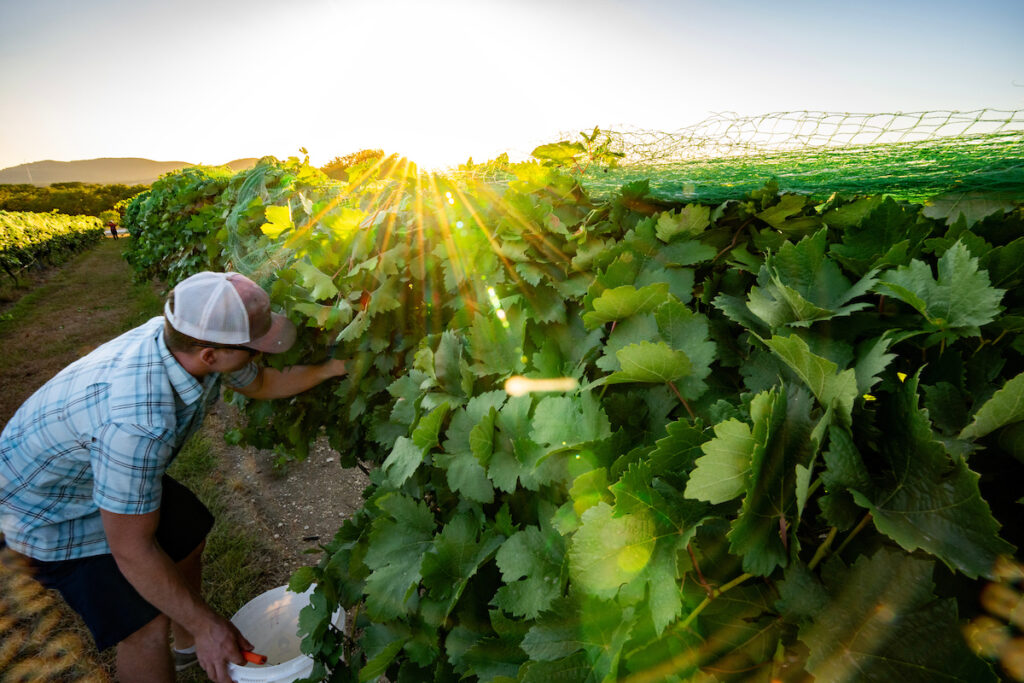Pierce’s disease is an ever-present factor for Texas wine grape growers.
Advancements in resistant wine grape varieties and science-based control methods have helped vineyard operators manage the deadly disease, but unfortunately it is here to stay said Jacy Lewis, manager of the Texas A&M AgriLife Extension Service Viticulture and Fruit Lab in Fredericksburg, homed within the Department of Horticultural Sciences at the Texas A&M College of Agriculture and Life Sciences.
Lewis said vineyards have experienced an uptick in the number of Pierce’s disease diagnoses during the 2024 growing season.
Contact a viticulture specialist
Our AgriLife Extension specialists can answer your viticulture questions.
“We’re seeing a dramatic increase in inquiries about Pierce’s disease, symptom presentation in vineyards and diagnosis,” she said. “I think it’s fair to say a healthy majority of vineyards in high-pressure regions of the state have been impacted.”
Conditions right for Pierce’s disease
Pierce’s disease impacts grapevines and can inflict large-scale damage to vineyards, resulting in significant economic losses to growers. The disease occurs when xylem-feeding insects like sharpshooters and spittlebugs act as vectors by feeding on diseased plant tissue and then transferring the bacterial pathogen to healthy plants nearby.
The rise in Pierce’s disease cases comes after back-to-back seasons of below average transmission between grapevines in regions where the disease is persistent, Lewis said. Over the past two seasons, significant cold snaps in the winter, followed by dry spring and summer conditions, likely held vector populations in check.
This growing season, however, followed a mild winter and started with good spring moisture conditions, which likely contributed to a rebound in populations of pests that vector Pierce’s disease. It is also speculated that there may be new strains of the bacterial pathogen with differential virulence, Lewis said.
“Conditions kept vector numbers lower over the past two seasons, which helped reduce transmission rates in high-pressure regions of the state,” Lewis said. “But I would consider this a high-transmission, high-pressure year resulting from vector recovery with early season rain, followed by extreme heat and late-season drought in some areas.”




Multiple factors fuel transmission
Lewis said the dramatic increase in inquiries and confirmed cases could be related to a confluence of factors.
In some instances, visual symptoms in infected plants have been atypical this season, she said. Primary signs of Pierce’s disease typically include foliar scorching patterns, green islanding, match sticking, shriveled fruit, generalized chlorosis and weak growth.
Another factor could be the recent explosion of interest in wine grape production, which in many cases might mean growers have had little to no experience growing wine grapes, Lewis said. The result could be related to inadequate or suboptimal Pierce’s disease mitigation efforts, like vector control regimens, as well as lack of prompt and accurate diagnosis and removal of diseased vines.
Some outbreaks also may have resulted from relaxed control regimens by experienced growers following light pressure in previous seasons, she said. Some growers may have gone into the season unprepared for increased vector activity.
Pierce’s disease fact sheet
Learn how to recognize and diagnose Pierce’s disease in Texas grapes.
Lewis said it is important to seek expert advice and testing, as symptoms that may mimic Pierce’s disease can be attributed to other causes and because it is important management approaches be based on accurate diagnosis.
“Growers may have seen symptoms but assumed it was not Pierce’s disease, so they didn’t seek diagnostic help,” she said. “It’s also possible some of our growers simply let their guard down. Sometimes it does take someone with more experience to recognize early symptoms of the disease and recommend testing.”
Stick to Pierce’s disease control plans
Lewis said Pierce’s disease will remain a concern in the Texas Hill Country, coastal and eastern parts of the state where it has been historically prevalent.
AgriLife Extension personnel are expanding and improving management options by trialing new Pierce’s disease-resistant wine grape cultivars, evaluating new control technologies, and increasing efforts to better understand the pathogen and the agroecological factors that impact disease pressure.
But Lewis said growers need to remain vigilant.
Vineyard managers should be assessing and scrutinizing their vines now because symptoms should be apparent and she recommends contacting your regional viticulture specialist for site specific advice on rouging strategies for disease management.
“The pathogen that causes disease has been found in all growing regions in the state, and Pierce’s disease management should be a basic component of all vineyard’s integrated pest management programming,” she said.
“That means implementing a vector control regimen, scouting for and learning to identify vectors and infected vines, and rouging those vines as soon as possible. This is a pathogen system that is complex and is constantly challenging our assumptions, and this season demonstrates why we must stay vigilant in management practices and continue the process of learning about the disease and the pathogen responsible for it.”





